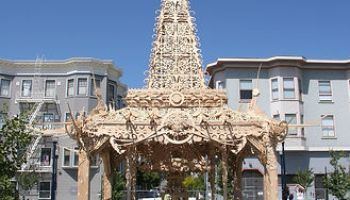Name David Best | Role Sculptor | |
 | ||
Books The rationality of feeling | ||
Black white bold printing for renowned artist david best
David Best (born 1945) is an internationally renowned American sculptor. He is well known for building immense temples out of recycled wood sheets (discarded from making toys and other punch-outs) for the Burning Man festivals, where they are then burnt to the ground in a spectacle of light and heat.
Contents
- Black white bold printing for renowned artist david best
- letting go the temple in derry londonderry by artist david best an artichoke project
- Career
- Burning Man
- Other similar projects
- References
letting go the temple in derry londonderry by artist david best an artichoke project
Career

Best received a master's degree in sculpture from the San Francisco Art Institute, where he first took classes at the age of six. His commitment to public art seems rooted in 1960s-era idealism. His works — ceramic sculpture, collages and more — have been shown at the San Francisco Museum of Modern Art, the Oakland Museum, the San Jose Museum of Art, di Rosa and elsewhere.

Best first began collaborating with others, 20 years ago, when he embarked upon a sideline: stripping down vehicles and giving them total sculptural makeovers, using recycled materials and found objects, often retrieved from dumps and dumpsters. Since then, he has created sculptures from the skeletons of 36 cars and two buses, and worked with more than 10,000 people.

Best built his first Burning Man Temple in 2000, The Temple of the Mind. During construction it became a memorial to Michael Hefflin, a member of the crew who died in a motorcycle accident just prior to the event, and as such became a sacred space for remembering others. In 2001, Burning Man helped fund the Temple projects and David, along with Jack Haye who was also responsible for the construction of the Temple of the Mind, built the much larger Temple of Tears. 2001 marked the beginning of a new and profound ritual for the tens of thousands of participants who attend Burning Man each year. After days of writing prayers on the structures, of affixing offerings from one’s life such as pictures, paintings, etc., or of leaving the ashes of loved ones, etc. the Temple was burned on Sunday night.
In 2002, Best returned with a new project: the Temple of Joy. In 2003, David departed from the wood temples and created the ornate paper Temple of Honor. In 2004, the Temple of Stars was a quarter mile long and almost 120’ high. David took a break in 2005 and 2006 to work on personal projects, including the Hayes Green Temple in San Francisco. Returning in 2007, David, Tim Dawson and the temple crew built the Temple of Forgiveness. Best originally suggested he might create one more temple in 2010 or 2011, however the 2010 Temple of Flux and the 2011 Temple of Transition were designed and built by other artists. Best returned in 2012 to design and coordinate the building of the Temple of Juno. In 2014, Best and crew constructed the Temple of Grace.
